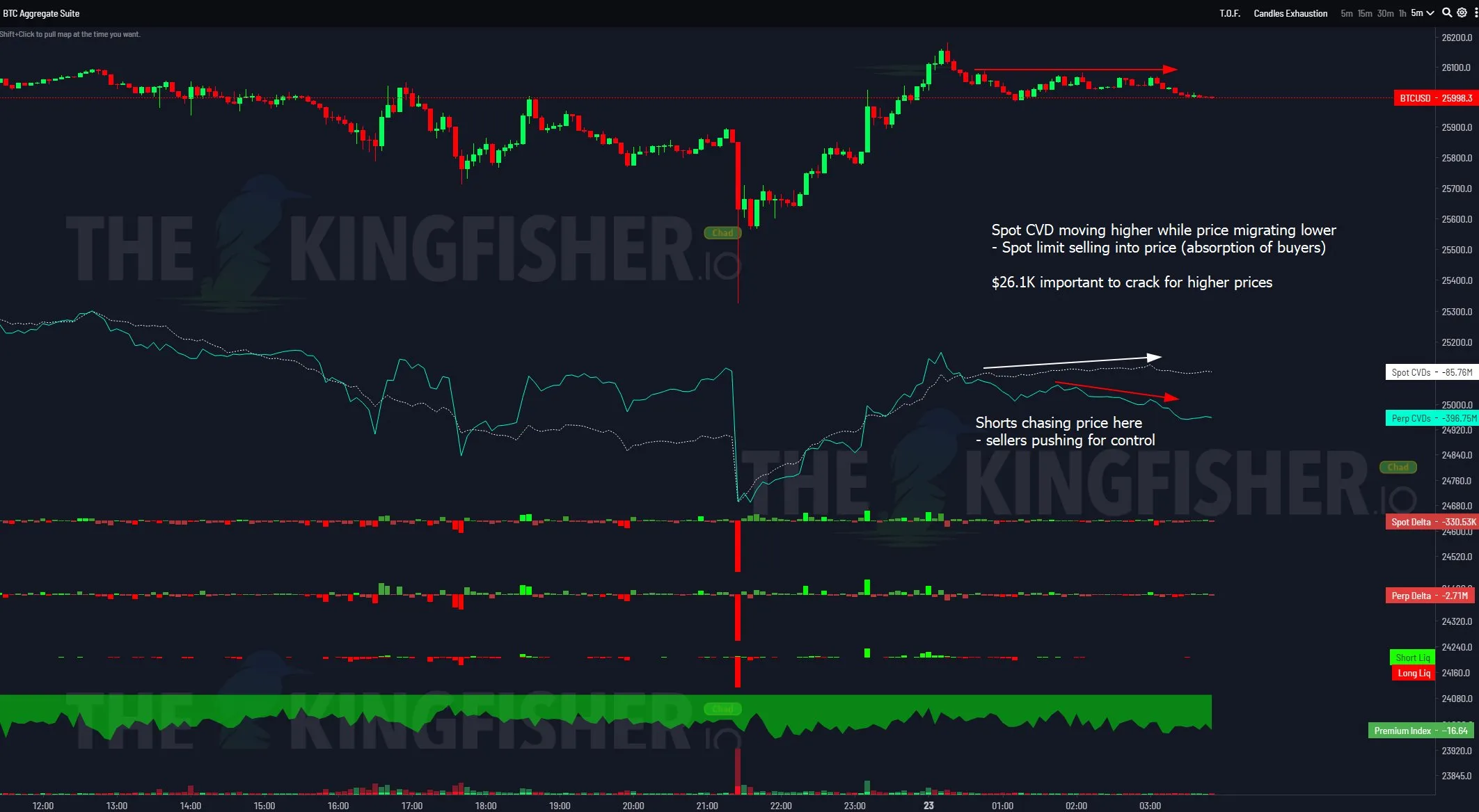- The Bitcoin market has surpassed the turbulent waters around $26,000, and there are several indicators to observe. After dropping to $25,300 yesterday, the bulls managed to pull the price back up.
- Famous analyst Skew highlighted the role of cumulative volume delta (CVD) in understanding the current market dynamics. “BTC Total CVDs and Delta show that spot sellers are defining their limits here and trying to control short positions.”
- Examining specific exchanges like Binance and Bybit adds more detail to the analysis. According to Skew, “Long positions fell below $25,800, thus identifying that level as a key turning point.”
The sudden drop in Bitcoin price to $25,300 has raised concerns among market participants: What will BTC do in this vulnerable situation?
Bitcoin Shows a Decline to $25,300 Levels
As the Bitcoin market surpasses the turbulent waters around $26,000, there are several indicators to observe. After dropping to $25,300 yesterday, the bulls managed to pull the price back up, but the market remains vulnerable following the price drop last Thursday.
Currently, Bitcoin’s Fear and Greed Index is at 37, which is considered a sign of strong fear engulfing the market. Typically, such a low level in this index indicates that market participants are concerned about the near-term future and often leads to a unique prophecy where selling pressure increases.
Famous analyst Skew highlighted the role of cumulative volume delta (CVD) in understanding the current market dynamics. “BTC Total CVDs and Delta show that spot sellers are defining their limits here and trying to control short positions.” This means that when traders consider buying at market prices, sellers set limits and add a ceiling to any short-term bullish momentum.
One specific price point to note is $26,100. “This level has acted as a magnet for limited sellers,” says Skew, “and is supported by the formation seen between spot CVD and price so far.” In other words, as buyers are absorbed by limited sellers at this price, it restricts upward movement.
It is worth considering traders who tend to close long positions and open new short positions in perpetual CVD. This indicates that traders are not only closing their long positions but also opening new short positions in line with the current downward trend.
Examining specific exchanges like Binance and Bybit adds more detail to the analysis. According to Skew, “Long positions fell below $25,800, thus identifying that level as a key turning point.” Open Positions (OI) on Binance decreased by 6,000 BTC, and Bybit OI decreased by 3,000 BTC – all liquidated long positions.
The liquidation of long positions at these levels poses an open risk for bullish scenarios. Skew says, “The net risk for long positions is below $25,800,” and emphasizes that it is an important level to watch for traders with net long positions.
MacroCRG, a renowned market analyst, noted that a significant amount of long positions were liquidated again during the BTC drop yesterday: “More pain for Bitcoin long positions as over $300 million in open positions were wiped out by a downward fluctuation. When will it end?”
However, as Skew suggests, there may be a silver lining: “It is likely to expect monkeys attacking short positions soon.” However, so far, Bitcoin’s Open Interest (OI) has followed a flat trajectory after the Thursday crash. The OI is currently at $10.88 billion (it was above $14 billion).
BTC’s OI-weighted funding rate has already returned to a positive level of +0.0060. If the value turns negative for a few days, as it did before the March 2023 rally, it could be a sign of a short squeeze. However, after the Thursday crash, the indicator remained in the negative zone for a short period of time.
BTC Short-Term Holders and Velocity
On-chain expert Axel Adler Jr. notes that the Short-Term Bitcoin Holders (STH) group has significantly reduced their holdings by 400,000 BTC. This mass migration has created significant selling pressure in the market and made many STHs less likely to exhibit bullish behavior.
Additionally, Adler emphasizes the BTC Velocity metric, stating, “Earlier this year, the BTC Velocity metric reached its lowest level.” This extremely low velocity indicates not only low volatility but also a lack of activity among market participants – a concerning sign for any potential bullish reversal. Therefore, Adler concludes:
“Taking these two factors into account and considering that the STH group is typically the main player causing volatility in the BTC market, recovery from this drop may require more time and an uncertain period than usual.”


